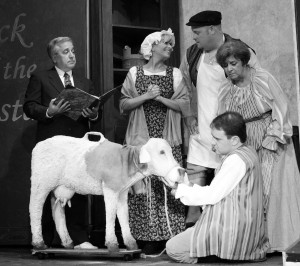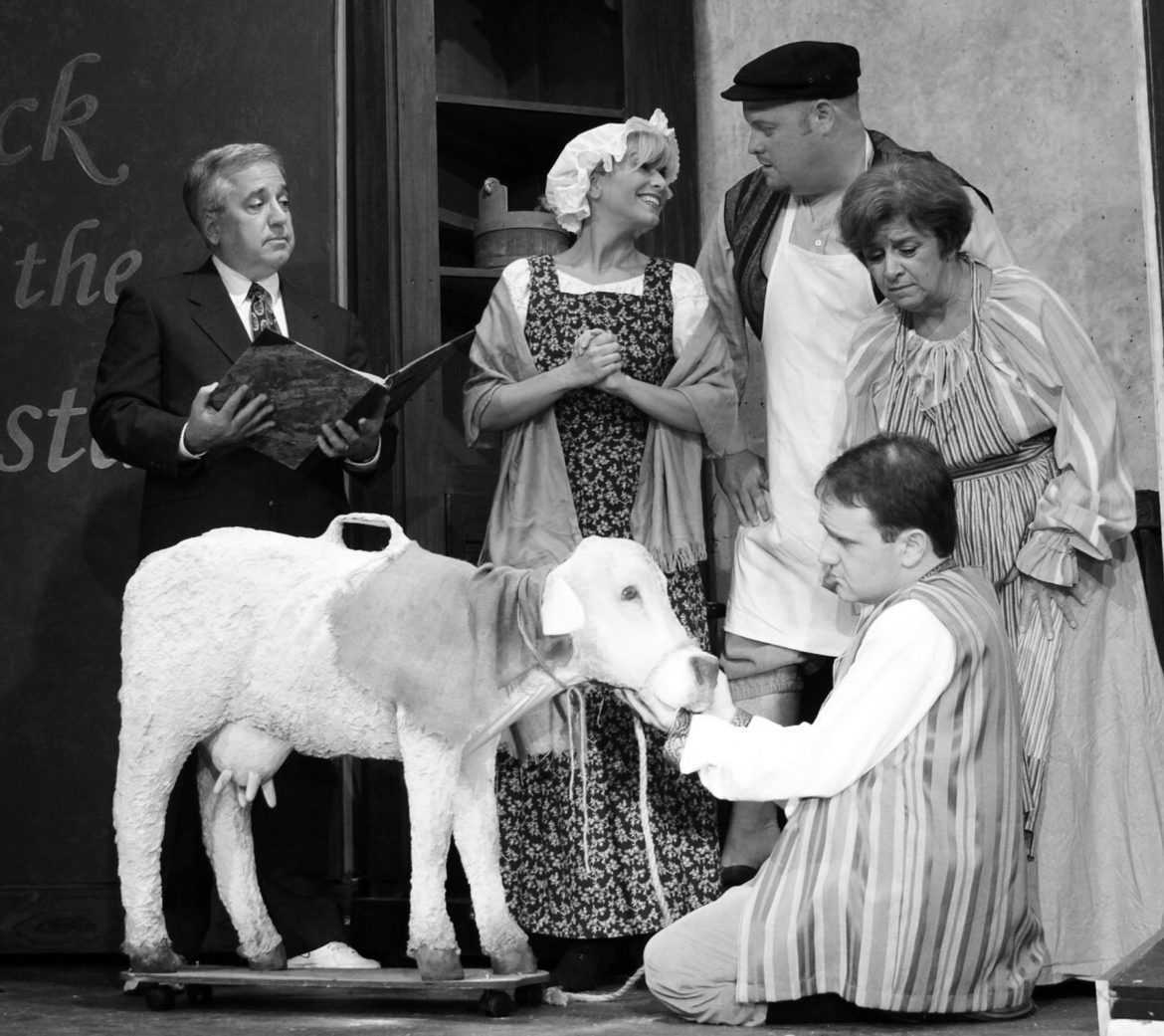Into the woods, It’s time to go,
I hate to leave, I have to, though.
Into the woods—It’s time, and so
I must begin my journey.

Steve Arcidiacono, Sandy Yozviak, Chris Di Meo, Linda Hunt & Paul Recupero in a scene from Narberth Community Theatre's INTO THE WOODS, running through November 19.
“Once upon a time, in a kingdom far away…” Each of us remembers hearing those words as we snuggled in our jammies at night. All of our childhoods were filled with the magical fables of princes and princesses. But, when one really examines the stories read to us as children, they are quite gruesome. The Three Little Pigs become homeless, Snow White gets put in a coma, Hansel & Gretel nearly get cooked, both Jack and Little Red are almost eaten, Rapunzel is basically kidnapped at birth and Cinderella is orphaned at a young age—lots of frightening things happen before the “Happily Ever After.”
Stephen Sondheim and James Lapine explored fairy tales—and whether there really is such a thing as a happy ending—in their 1986 musical INTO THE WOODS. The show debuted in San Diego at the Old Globe Theatre in 1986, and premiered on Broadway in 1987, winning several Tony awards that season (beating out Andrew Lloyd Webber’s THE PHANTOM OF THE OPERA). The musical has been produced many times, with a 1988 national tour, a 1990 West End production, a 1991 television production, a 1997 tenth anniversary concert, a 2002 Los Angeles production and a 2002 Broadway revival. And now, it’s onstage at the Narberth Community Theatre from November 4th thru the 19th.
Sondheim and Lapine were inspired by Bruno Bettelheim’s 1976 book, The Uses of Enchantment, in which the author analyzes fairy tales in terms of Freudian psychology. In the book, Bettelheim discusses the emotional and symbolic importance of fairy tales for children, including traditional tales by the Brothers Grimm. When one researches these stories, the originals are very dark, rife with tales of abandonment, death, witches and injuries. Bettelheim felt they allowed children to grapple with their fears in remote, symbolic terms, giving them the means to go through emotional growth that would better prepare them for their own futures. You know, your typical inspiration for a Broadway musical…
INTO THE WOODS intertwines the plots of several Brothers Grimm fairy tales and follows them further to explore the consequences of the characters’ wishes and quests. The main characters are taken from the stories of Little Red Riding Hood, Jack & the Beanstalk, Rapunzel and Cinderella, tied together by a more original story involving a Baker and his wife and their quest to begin a family. (This plotline most likely comes from the original story of Rapunzel by the Brothers Grimm.) The musical also includes references to several other well-known tales, such as Snow White. This is NOT a Disneyfied tale of sweetness and light; rather it is a musical exploration of coming to the realization that life doesn’t always work out the way we wish it to. The ultimate message, though, is that one can’t go through life alone; we all need the help of friends and loved ones.
To be honest, I’m not a big fan of musical theatre, but I am a HUGE fan of Stephen Sondheim—the man is a genius. I have seen, and loved, several of his productions—including the original company of his masterpiece SWEENEY TODD. I am not a musician, but I do know that Sondheim is a real challenge for singers. His melodies are multi-faceted and his lyrics sublimely clever. In his director’s notes, Steve DiNenno states, “Sondheim is like Shakespeare, you have to get it right or it just doesn’t work.”
For the most part, the Narberth company gets it right. The cast of INTO THE WOODS is large, and generally very experienced. Leading things off was a solid Steve Arcidiano as the Narrator/Mysterious Man. The main roles were played by Paul Recupero (the adorably clueless Jack, who touches hearts singing goodbye to his beloved cow), Linda Galati Hunt (his long-suffering mother), Tara Bennett (the deprived Cinderella), Chris DiMeo (the Baker) and Sandy Yozviak (the Baker’s wife). These last two were very strong, playing off each other and their cast mates nicely. Their numbers “Maybe They’re Magic” and “It Takes Two” were wonderfully sung. Raina Frey Murdock was impressive in the pivotal role of the Witch; she has a powerful voice, which was beautifully on display in both “Last Midnight” and “Children Will Listen.”
Jacqueline Sergent plays Little Red Ridinghood. She’s joined by Todd Engelmann (as The Wolf) for the funny “Hello Little Girl”. Engelmann reappears later as Rapunzel’s Prince; he’s joined by Howard Frankel as Cinderella’s Prince, as the two sing the clever “Agony”. (Apparently, being a prince is tough). Kit Niesen is adorably vapid as the trapped Rapunzel. Rounding out the ensemble are Betsy Oliphant, Kim Albright, Jenn Webly, Rachel Koester, Doug Smith, Julie Powell Leavitt and Vince Capriotti.
The set, designed by the director and his wife, Marianne, makes fairly good use of Narberth’s smallish stage and lack of wing space; but some of the scene changes are a little clunky and long. Hopefully this will tighten up as the run progresses. I also found it frustrating to be leaning around the conductor to see a couple of moments played at center stage. They might want to consider re-configuring the pit layout. BUT—kudos for getting a full orchestra to play! I know many theatres in the area that have to resort to other options because they cannot put together a full pit. Another issue I had was the body mikes—in an effort to have the singers heard over the orchestra, a number of times the mikes were up so loud it made the performers sound shrill; it was disconcerting and took me out of the moment.
Solid technical support is turned in by costumer Christine Jackson and her crew, lighting designer Tim Bean and Music Director Konnie Stark, as well as scenic artists Susan Davit, Faithe Hornung and Susan Strieb—their forest (complete with distant castle) is lovely.
The performance space is in the basement of the United Methodist Church at the corner of Price and Essex Avenues in the borough of Narberth. I attended the first Sunday matinee, and was pleased the theatre had a relatively full house—they appear to seat about 150. There were a number of very young children in attendance, and I couldn’t help but wonder if they would understand the many levels of the story. Like I stated earlier, this is not Disney-like light fare. I would be very curious as to what their reactions were. But, if you like intelligent, challenging musicals, head on over to Narberth Community Theatre to catch a performance of INTO THE WOODS over the next two weekends.
INTO THE WOODS
by Stephen Sondheim & James Lapine
Directed by Steve DiNenno
Musical Direction by Konnie Stark
November 4-19, 2011
Narberth Community Theatre
206 Price Avenue (@ the corner of Essex Avenue)
Narberth, PA 19072
610-352-4823
www.narberthcommunitytheatre.org


